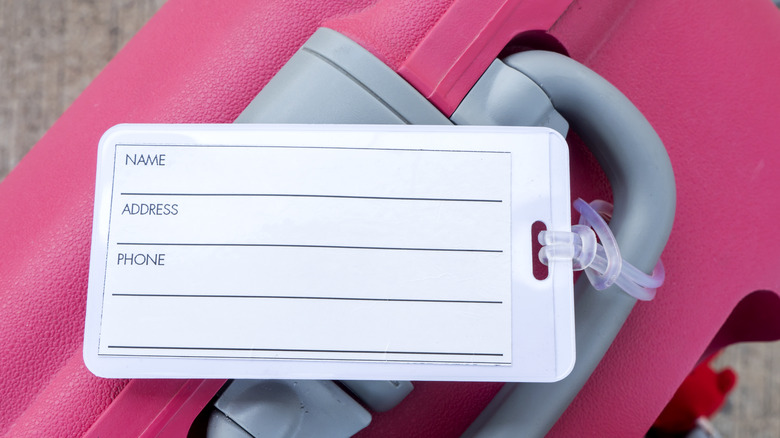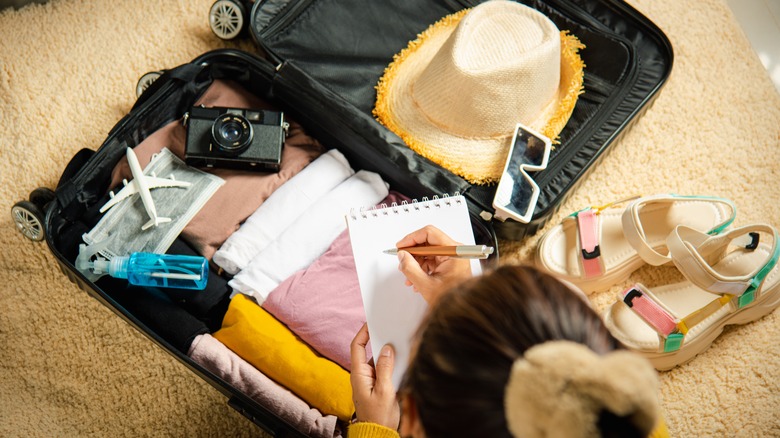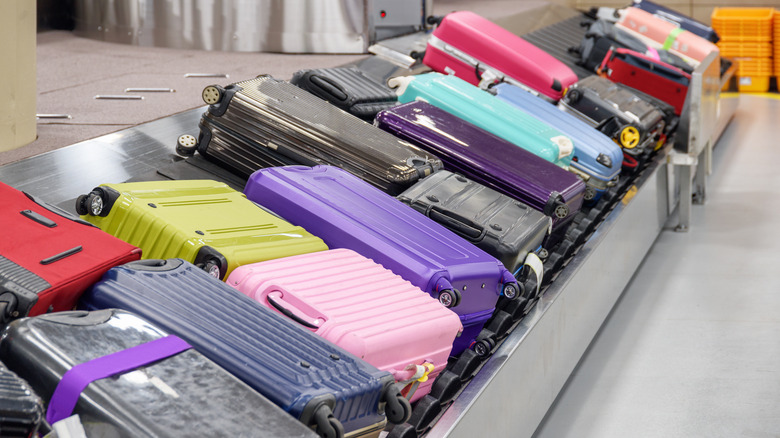What You Should (And Shouldn't) Put On Your Luggage Tag
Packing a suitcase for an upcoming trip takes time, effort, and planning. Whether adventurers are heading out for a much-needed vacation or traveling for work, making sure everything is safely tucked away in luggage can feel like an art form. The last thing you want to worry about once a suitcase is packed and ready to go is losing it in transit.
Unfortunately, mishandled luggage is a stark reality of modern travel, particularly in the skies. Human error plays a significant role in lost luggage scenarios in light of the massive numbers at play. In December 2022 alone, the United States Bureau of Transportation Statistics saw U.S. airlines handling over 40 million bags. For the entire calendar year, a 1.09% mishandled baggage rate was reported.
It's impossible to guarantee that checked luggage is going to get where it's going successfully on every trip. However, there are some simple steps you can take to reduce the risk of lost baggage including adding a luggage tag to your suitcase. A luggage tag can help with identifying and tracking your baggage in transit, but what you put on the tag is just as important as adding it to your suitcase.
Essential information on a luggage tag can be helpful in the event it gets lost. There are other pieces of information travelers may be tempted to add to a tag that should be left off instead. Knowing the difference can keep your luggage and your personal information safe as you travel.
Information you'll always want to include
Many travelers take time to add a luggage tag to the suitcases they plan to check-in. However, it's just as important to add a luggage tag to carry-on bags. In the event an airline overbooks a flight, there's a chance a carry-on will have to be checked at the gate and already having a tag in place helps with tracking.
The essential information to include on a luggage tag should be the same for checked and carry-on baggage. Travelers will want to begin by clearly writing their first initial and full surname on the first line. Sticking with a first initial is enough for airlines to track luggage through a flight manifest, but keeps your personal information exposure to a minimum.
The second line of the luggage tag should include an email address. Consider creating a special email address specifically for travel. This keeps your primary address far from any potential phishing attempts and provides a single place to get updates if your luggage gets lost.
A mobile phone number complete with your country code and area code should be included on the last line of a luggage tag. These three lines of information are sufficient for tracking baggage in the event it's mishandled. Those who want some added peace of mind can always fill out a second luggage tag and place it inside the main compartment of the suitcase as a backup if the exterior tag gets torn off during travel.
Feel free to leave a few details out
It's easy to assume that if your luggage gets lost, airlines will immediately be looking for a home address listed on your luggage tag. In reality, this is one piece of information to make sure you leave off a luggage tag altogether when you travel. Your suitcase is viewed by countless other travelers and airline employees while in transit. Making your home address so readily available can be a cause for concern when it comes to home safety as well as your personal safety while traveling.
Special consideration should also be given to what's left off a child's luggage tag when you're traveling with little ones. Out of habit, parents may fill out a luggage tag with their child's name and information on it just as they would for their own luggage. For security purposes, it's better to avoid using a child's name on a luggage tag at all. Instead, fill out their tag to match your own so any lost luggage information will be directed to the adult in the group and your child's privacy remains a priority.
Depending on where in the world you're traveling, it's usually best to not put anything on a luggage tag that would identify you as a citizen of a specific country. This means avoiding flag-themed tags or listing your nationality on the card. This simple elimination helps avoids any targeted issues based on cultural tensions as luggage makes its way across borders.


